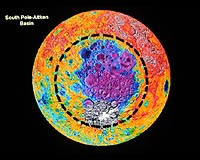 |
El Segundo CA (SPX) Jul 29, 2009 Sensing technology developed by Raytheon for the U.S. Navy's miniaturized radio frequency system has begun its one-year mission to determine whether the polar regions of the moon contain ice. Launched aboard NASA's Lunar Reconnaissance Orbiter June 18 and activated July 8, the system, known as Mini-RF, will take high-resolution radar imagery of permanently shaded regions of the moon to attempt to detect ice in areas hidden from other instruments. Under contract to the U.S. Navy, Raytheon provided the antenna, transmitter, analog receiver and software for the system. "This is an important mission for our nation because it represents the first step in the next era of lunar exploration," said Bill Hart, vice president for Raytheon's Space Systems business. "The Mini-RF system will play a key role in determining how we will approach this next phase of the space age." Water ice, deposited as a result of asteroid collisions, is hypothesized to exist in permanently shaded regions of impact craters at the lunar poles, protected from dissipation by the sun. However, that theory lacks proof. NASA is interested in determining the extent to which lunar ice exists, if at all, as the agency prepares for future manned exploration and possible habitation on the moon. Raytheon provided similar support under the same contract for the Indian Space Research Organization's Chandrayaan-1 lunar orbiting mission. That spacecraft's miniaturized synthetic aperture radar (known as Mini-SAR) provided images between mid-February and mid-April. Data obtained during that period are being analyzed for evidence of ice on the lunar surface. The Mini-RF technology of the Lunar Reconnaissance Orbiter differs slightly from what is flying aboard Chandrayaan-1. The LRO version features slightly higher resolution capabilities and will operate in dual S- and X-band modes. It also will fly at a lower orbit than Chandrayaan-1. Raytheon's work on the Mini-RF and Mini-SAR programs illustrates the type of design and manufacturing innovations the Department of Defense advocates as part of its operationally responsive space initiative. That initiative calls for the development of smaller, less-expensive satellites that can be deployed in tactically relevant time frames. Manufactured and delivered within 15 months of design approval, the Mini-RF system provides a wealth of sensing capabilities in a relatively inexpensive and easily adapted platform. "There is a great need within the military and civil space communities to be able to effectively augment or reconstitute critical space capabilities and infuse them with new technologies and operational innovations," Hart said. "Our experience on this and other similar short time-frame programs has taught us a lot about what is required, not only on the manufacturing floor, but throughout a program's life cycle to make that possible." Share This Article With Planet Earth
Related Links Raytheon Mars News and Information at MarsDaily.com Lunar Dreams and more
 Maximizing Scientific Return Of The Moon Rovers
Maximizing Scientific Return Of The Moon RoversTucson AZ (SPX) Jul 28, 2009 NASA and other national space agencies are again focused on lunar exploration, which raises the question of how to best use semi-autonomous rovers to explore the Moon's surface. R. Aileen Yingst, a senior scientist at the Tucson-based Planetary Science Institute, is leading a group of Mars-rover veterans who are conducting field studies to answer that question. The scientists are ... read more |
|
| The content herein, unless otherwise known to be public domain, are Copyright 1995-2009 - SpaceDaily. AFP and UPI Wire Stories are copyright Agence France-Presse and United Press International. ESA Portal Reports are copyright European Space Agency. All NASA sourced material is public domain. Additional copyrights may apply in whole or part to other bona fide parties. Advertising does not imply endorsement,agreement or approval of any opinions, statements or information provided by SpaceDaily on any Web page published or hosted by SpaceDaily. Privacy Statement |